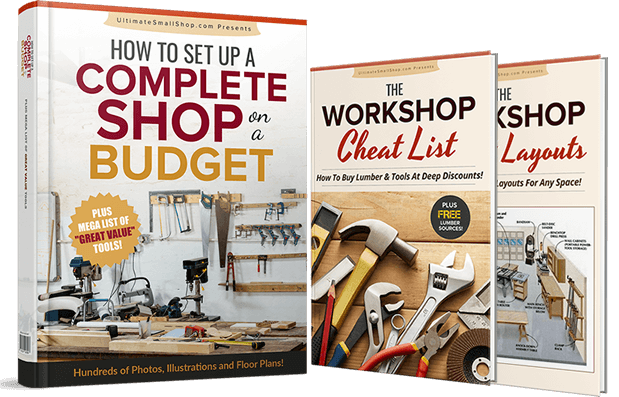



Challenging Conventional Wisdom: The Real Secret to Your Ultimate Small Shop
Ratings: 5/5⭐⭐⭐⭐⭐ (4.5K)

What if everything you’ve been told about setting up your woodworking shop is wrong? What if all the rules, all the well-meaning advice, and every assumption you've ever made about space, tools, and budget—all of it—is just... misleading?
Here’s something shocking: Conventional wisdom is often a trap. Yeah, I said it. It's comfortable. It’s easy to follow. But it’s also outdated. If you believe the usual advice about what it takes to create a successful woodworking shop, you’re probably setting yourself up for unnecessary frustration. More tools, bigger space, bigger budgets—that’s the old school thinking. And guess what? It’s holding you back.
But let’s take a moment here, okay? Let’s pause and think: What if the real secret to building your Ultimate Small Shop is by doing the exact opposite of what everyone else is telling you?
Why Conventional Wisdom is Not Your Friend
Let me ask you something: when you think about your dream shop, what comes to mind? A huge space, gleaming high-end tools, a big budget for everything, right? That's what everyone says you need, right? Wrong. I get it, trust me. I used to think that too. I thought my shop would never be “real” unless it was filled with top-of-the-line equipment, neatly spaced out with room to breathe.
But here's the thing—conventional wisdom isn’t just wrong; it's dangerous. Why? Because it forces you into a box. A box where you feel like you need more space, more tools, and more money. But here’s what no one tells you: that box keeps getting smaller and smaller the more you follow it.
Think about it. We’re constantly told to spend big to get the best, to get the latest and greatest. And you know what? It doesn’t always work out. Sometimes, the more you buy, the more frustrated you get because you don’t have the space to use it all. Or worse, you realize that the tools you’ve been obsessing over aren't even necessary. So what happens next? Well, you end up stuck. Overwhelmed. And maybe even a little discouraged.
But hey, this is where things get interesting. This is where you get to rewrite the rules.
Insight #1: Small Spaces Are Your Secret Weapon—Big Isn’t Always Better
Let’s start with the big myth. More space doesn’t always mean more freedom. In fact, bigger spaces often lead to wasted potential. You know, the bigger the space, the easier it is to get distracted. It’s like that giant kitchen you have. You thought it’d be amazing, but now it feels like it takes forever to walk to the fridge.
Here’s the thing: when you have a smaller space, you’re forced to be more creative, more efficient. Every inch matters. Every tool has to count. You can’t just throw a bunch of machines in and call it a day. No, you have to optimize. You’ve got to think about how each tool fits into your workflow, how every corner of your shop can serve multiple purposes.
Why This Works:
In a bigger space, you’re less likely to think about optimization. Why? Because you have room to breathe. And that’s the problem. You don’t really think hard enough. But when you’re crammed into a 10x10 space (or less), your brain kicks into overdrive to figure out how to maximize every square inch. Necessity breeds creativity.
Real-World Example:
Andy, remember him? He didn’t have a fancy, huge workshop with endless space. But what he had was a tiny garage, a willingness to make do, and a need to optimize. He learned how to use every inch of his space. When you look at his shop, it doesn’t feel cramped; it feels organized, efficient, and—dare I say—ingenious. Every tool has a place, and every piece of space has a purpose. He didn’t just make it work—he thrived.
Actionable Steps:
- Use vertical space: Shelves, pegboards, racks—anything you can mount on the walls, use it.
- Create movable workstations: Mobility means flexibility. Move your tools around based on what you need that day.
- Think modular: Your shop should adapt to your needs, not the other way around.
Insight #2: You Don’t Need High-End Tools, You Need The Right Tools
Here’s the cold, hard truth: You do not need the most expensive tools to do great work. Period. I know, I know—it’s hard to wrap your head around it. We’ve all been told the lie that the best tools = the best work. But guess what? That’s not always the case. It’s a trap.
Why This Works:
High-end tools might look amazing on the shelf, but are they really what you need? Not necessarily. It’s not about the tool; it’s about how you use it. A high-quality $100 tool might be fantastic, but if it doesn’t fit your needs or if you don’t know how to make the most of it, then it’s just sitting there, gathering dust.
Real-World Example:
Ralph Chapman didn’t build his first workshop with brand-new, top-of-the-line tools. He used second-hand tools, carefully chosen based on what actually mattered for the projects he was doing. And guess what? He didn’t just “make do.” He created high-quality, intricate woodworking projects using tools that cost him a fraction of what others would have spent.
Actionable Steps:
- Buy for utility, not brand: Go for tools that are versatile and suit your needs—not the ones with the biggest name behind them.
- Buy used or refurbished: Many tools are just as good second-hand. Just make sure they’ve been well-maintained.
- Don’t get obsessed with the latest model: Focus on tools that serve your specific tasks, not the ones with the most bells and whistles.
Insight #3: More Tools Don’t Mean More Productivity—It Means More Distraction
This one is going to sting a little, but hear me out: More tools equal more distractions. The shiny new gadgets, the latest machines, they’ll tempt you, and you’ll buy them, thinking they’ll magically solve your problems. But in reality, they’ll just clutter your workspace, both physically and mentally.
Why This Works:
Having more tools often means you spend more time figuring out which tool to use, more time cleaning up, more time maintaining them. This is the paradox of abundance: when you have more choices, you get stuck making decisions instead of doing the work. Simplicity breeds focus.
Real-World Example:
Look at Andy again. He didn’t fall for the “tool overload” trap. Instead, he focused on getting the essential tools—the ones that were multifunctional, the ones he could rely on for multiple tasks. He didn’t get caught up in the marketing hype. And as a result, he spent less time deciding which tool to use and more time making.
Actionable Steps:
- Focus on core tools: Limit your toolset to the ones you’ll use every day.
- Create a clear work flow: Don’t let tool choices slow you down. Plan your tasks so you know which tools you need before you start.
- Streamline your shop: Don’t fill your space with tools that are only useful once in a while. Prioritize what you actually need.
Insight #4: Forget About Big-Box Retailers—They’re Not Your Friend
The advice is everywhere: head to Amazon, Lowe’s, or Home Depot for your woodworking tools. Sure, they’re convenient, but they are not your best source for quality or savings. Let’s face it—retailers like these are in it for the volume. They move products quickly, but they don’t necessarily offer the best prices or the best tools.
Why This Works:
Big-box stores are about mass-marketing. They push you to buy, and then you end up paying for the convenience. But that doesn’t mean you’re getting the best deal. You need to seek out the specialists. There are small, specialized suppliers that offer better deals and tools that will actually serve you well for years.
Real-World Example:
Ralph Chapman’s personal “rolodex” of suppliers is a goldmine—hidden, trusted sources that give you quality tools for a fraction of what you’d pay at the big stores. These suppliers often don’t get the same level of attention, but their tools perform as well, if not better, than the ones sold at big-box stores.
Actionable Steps:
- Find niche suppliers: Look beyond Amazon and Lowe’s. Search for smaller, specialized retailers that cater to woodworkers.
- Use Ralph’s insider knowledge: Consider subscribing to tools and deal alerts to stay ahead of sales and discounts.
- Consider second-hand options: Estate sales, auctions, and even Craigslist can offer great deals on quality tools.
Conclusion: Break the Rules—Write Your Own Success Story
Here’s the thing—the traditional way is often the wrong way. It’s not about having more space, more tools, or more money. It’s about optimizing what you have, focusing on what truly matters, and throwing out the myths that hold you back.
The Ultimate Small Shop guide isn’t about fitting into some preconceived mold—it’s about shattering that mold. It’s time to challenge the conventional wisdom. To stop thinking that bigger, faster, and more expensive is always the answer. It’s not.
You’ve got the tools you need. You’ve got the space you need. Now, all that’s left is for you to take control and build the workshop you’ve always dreamed of.
It’s your time. Challenge what you’ve been told. Don’t follow the herd. Create your own path. And most importantly, prove the old rules wrong—because you can.
Related Tags
#ultimatesmallshop #ultimatesmallshopReview #ultimatesmallshopReviews2025 #ultimatesmallshopAppReview2025 #ultimatesmallshopBonus #ultimatesmallshopProduct #ultimatesmallshopPrice #ultimatesmallshopOffers #ultimatesmallshopBonuses #ultimatesmallshopBuy #ultimatesmallshopWebsite #ultimatesmallshopSite #ultimatesmallshopApp #ultimatesmallshopHonestReviews #ultimatesmallshopLatestReviews #ultimatesmallshopUsersExperience #ultimatesmallshopUsersReview #ultimatesmallshopDemo #ultimatesmallshopTutorial #ultimatesmallshopPurchaseOnline #ultimatesmallshopBuyit
